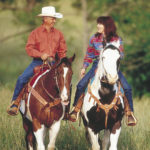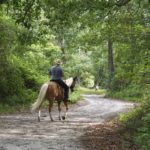Trail riding is an excellent way for riders and horses to bond and work on communication aids in a new environment. Training outside the box is something that AQHA Professional Horsewoman Lynn Palm does with all her horses in training, especially the competition horses. It is an opportunity to strengthen the bond by overcoming new obstacles together and encountering situations not found in an arena setting. However, riders must always be prepared to confront the unexpected when out on the trail.

Here is Palm’s list of 40 tips for the trail rider to be prepared, confident and successful:
# Preparation Before hitting the trail, you and your horse should have mastered basic skills in an arena, such as stopping and turning, as well as having control at all gaits.
# Make sure the distance and duration of the trail ride is within your horse’s current fitness level.
# Keep tack in good condition to prevent anything from breaking on the trail.
# Groom your horse thoroughly before trail riding.
# Put protective leg wear, such as polo wraps or boots, on your horse. I love to use Professional?s Choice boots.
# Use insect repellent for both you and your horse.
# Remember to check the weather before you ride and dress accordingly.
# Riders and light-skinned horses should use sunscreen to protect against harmful UV rays.
# Before leaving the barn, trailer or campsite, make sure your horse’s shoes are tight and tack is fitting properly.
# Plan your route and stick to equestrian-approved paths.
# If you plan to stop and tie your horse, take a halter and lead rope with you.
# Make sure you let someone know where you are going and when you expect to be back. Also let a friend or family member know where the keys to your various vehicles are. They should be accessible in case anyone is injured.
# Do not go on the trail without some warm-up for you and your horse. I always do stretching exercises to loosen up and longe my horse on a 20-meter circle for at least 20 minutes.
# On the Trail Never hit the trail without a buddy, and never leave the buddy behind.
# Wear a certified helmet that fits snugly and always buckle the chin strap.
# Always carry a fully charged cell phone or satellite phone, first-aid kit (EquiMedic has the best first-aid kits on the market), flashlight, water, hoof pick, map, compass and GPS receiver. Take advantage of the technology available to you.
# Carry an ID and put identification information inside your helmet. Be sure to include your name, address, phone number and emergency contacts.
# Be prepared to confront common problems that can go wrong with your horse such as lameness, laceration, colic, tying up and snake bite.
# Know how to monitor your horse’s vital signs and be able to administer first-aid to both horse and human.
# Make sure to rest and walk after periods of trotting. Don?t over do it!
# Use your manners! Be friendly to other people you encounter on the trail.
# Leave one horse length between horses, two if trotting.
# Pass on the left at reduced speed after giving the person you are passing a verbal heads up.
# Always be aware of your surroundings and think ahead so you don’t put yourself or your horse in a dangerous situation.
# Be a proactive rider. Avoid riding on footing that can be hazardous to your horse such as roots, holes and debris.
# Change positions within your group and do transitions often. This will help the horse wanting to be at the front all the time, as well as keep the horse concentrating on you and not the outside environment or other horses.
# If your horse spooks on the trail, it is OK to get off the horse to address the spooky obstacle. It is safer to deal with a sticky spot on the ground than under saddle.
# To encourage your horse to be willing and obedient on the trail, be his leader! This means you, the rider, are always in control. Move your horse the opposite way he wants to take you. If he goes left, go right; if he goes right, go left; if he backs, go forward; if he goes forward without you asking, stop and back a few steps. This works the horse’s mind and reminds him that you are the leader. As your horse’s leader, he will trust you!
# When approaching new obstacles that might frighten your horse, stop and let your horse address them in a safe manner. Let him swing his head to see it from both eyes and let him smell it. Take your time. Once your horse learns to trust you, the next obstacle you address will take less time to accept.
# If your horse gets too close to a tree or obstacle and might hit it, slightly turn his head pointing his nose toward it and use your inside leg aid (leg closest to the obstacle) to yield him away from the obstacle. If you use too much rein aids, you will actually turn him more into the tree.
# AQHA?s Buying and Owning Your First Horse has great information about developing a meaningful relationship with your new horse and getting the most out of horse ownership. Download your copy today!
# Use your body position to help maintain your horse’s balance while traveling uphill (tilt upper body forward, extend arms up the horse’s neck to give him his head) and downhill (lean upper body back, push feet forward in stirrups so legs are in front of the cinch/girth, and hold reins approximately three to four inches higher than usual).
# At a water crossing, pond, river or lake, stop and offer the horse water.
# Try to know the depth of a water crossing before attempting to cross it.
# Always remove a tie-down or martingale before crossing a water obstacle in case you encounter a deep spot. These devices restrict your horse’s head so much that he won?t be able to swim.
# Socializing on the trail with your friends can be fun, but remember to always pay more attention to your horse and his body language than to a conversation.
# Always have your horse walk on the way back to the barn to prevent him from learning to rush home.
# After the Ride Make sure to cool your horse down properly to relieve and prevent lactic acid buildup in the muscles.
# Check to see if your horse sweated evenly under the saddle pad to make sure your saddle doesn’t have any pressure points that can make your horse uncomfortable or cause long-term problems.
# Rinse or hose off sweat and always offer fresh clean water.
# Do a visual and tactile evaluation of your horse. Check his legs for swelling or any cuts he might have from the ride. Treat accordingly.





